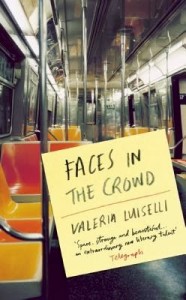What We’re Reading: Faces in the Crowd

Faces in the Crowd by Valeria Luiselli (Coffee House Press, 2014)
A mother in contemporary Mexico City writes a novel about her past. A young translator living in New York City, obsessed with the poet Gilberto Owen, finds traces of him in Harlem and on the subway. Owen loses weight, loses sight, and is slowly disappearing in 1950s Philadelphia, dreaming of his past and his prime in New York City.
Luiselli’s first novel (translated by Christina MacSweeney) tells a story of love and loss. Her writing blurs the line between life and death across three narratives that overlap in content and time, leaving much up for the reader to accept or dismiss as reality.
We read the novel that the unnamed (and unreliable) narrator in Mexico City is writing about her youth in New York. We are introduced to the eclectic acquaintances who pass through her otherwise nearly empty apartment with keys she’s given away. We watch her follow the Gilberto Owen’s past and convince her boss at a small publishing house to publish translations of Owen’s poems.
As she writes in Mexico City, she claims the novel is a “horizontal novel, told vertically”, or perhaps a “vertical novel told horizontally”; she tells her young son it’s a ghost story. Her husband asks questions about the book, revealing that she has imagined some pieces of her past, leaving it to the reader to decide what to believe is fact or fiction, who is a ghost or who is a living memory.
Eventually, Gilberto Owen joins as a narrator, and while he’s disappearing in Philadelphia, he’s remembering his past in New York City, He sees a young woman with sad, tired eyes, often on a subway train running momentarily parallel to his. Then one speeds up, and they’re no longer locked in synchronicity. This image is repeated from the perspectives of both Owen and the young translator, who impossibly meet each other at the same time and place.
The narrator reflects:
The subway, its multiple stops, its breakdowns, its sudden accelerations, its dark zones, could function as the space-time scheme for this other novel.
The stories and memories span nearly 100 years and take place in New York, Philadelphia, and Mexico City for all narrators, unhinging the reality of time and place that we understand. If you’re able to let go of that reality and follow the story the way it wants to be told, you’ll fall into the pages and believe the connections between people—ghosts or not—to be true.
At times I had to re-read pages to be sure I knew who was speaking, and most importantly, when they were speaking. Luiselli crafts her narrations to flow so seamlessly together that sometimes the last word spoken by one will be the first spoken by the next. Certain objects reoccur in many scenes, from the narrator’s red coat that Owen catches her in, to the dead tree he left in his Morningside apartment that she later discovers and attempts to revive.
The female narrator lives with the dead tree at her writing table. Based on the narratives overlapping in different time periods, you might start to believe the unreliable narrator when she says she’s writing a ghost story. She happens to find comfort in death:
In a way, I was living in a perpetual state of communion with the dead. But not in a sordid sense. In contrast, the people around me were sordid… The dead and I, no. I had read Quevedo and internalized, like a prayer, perhaps too literally, the idea of living in conversation with the dead. I often visited a small graveyard a few blocks from my apartment, because I could read and think there without anyone or anything disturbing me.
The narratives inch closer and closer together, until they meet in the same present, which was satisfying after feeling them slowly connect, piece by piece. Through the carefully crafted sentences that make up each intriguing shift in narration, the novel ends up telling just one story (where space and time are irrelevant): a story about poetry, mortality, memory, and about writing a story, the themes of which appear slowly—then all at once—in each perspective.
How does a story change when time and place are no longer relevant? When reading a novel with unreliable and shifting narrators, what can you gleam as “truth” for the story, when in our reality it’s all truly fiction?






